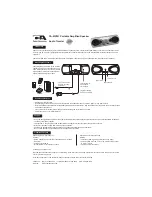
10
48-00
60706-51
** NOTICE **
The trickle charger is not intended to recharge a battery which
has become completely discharged. It is designed to produce
just enough current to maintain a fully charged battery.
The battery tender receptacle is to be powered by a GFCI circuit
and installed in accordance with the United States National
Electric Code. These AC wires can be run in the same conduit
as the other AC leads from the generator. It is suggested that
this circuit be fused for 15 amps, then both the battery charger
and the block heater can be connected to the same circuit. A
10 volt duplex receptacle is mounted on the generator along
side circuit breaker panel, the battery tender is shipped already
plugged into the receptacle.
The engine blockheater installed on this unit should also be
plugged in this receptacle. The block heater is thermostatically
controlled and when plugged in will maintain the engine coolant
temperature between 100 and 10 degrees F.
MOUNTING THE AUTOMATIC
TRANSFER SWITCH (A.T.S.)
****************
***** WARNING *****
****************
FIRE HAZARD -
All wiring must be done by a licensed
electrician, and must conform to the national electrical code and
comply with all state and local codes and regulations. Check
with the local authorities before proceeding!
INSTALLATION NOTES
Because of the many different types of service, feeder, and
distribution equipment, no specific wiring instructions can be
provided. It is recommended that only copper wire be used.
In all cases it is essential that while the load is connected to
the generator, there can be absolutely no feedback from the
generator to the power line or the power line to the generator.
When properly installed, the normal A.T.S. Control and safety
systems will eliminate all paths for feedback.
To wire the automatic transfer switch into the existing wiring, first
determine which circuits will be on the emergency load circuit.
If the entire load is to be transferred, the transfer switch can
be wired in directly after the watt-hour meter and the service
entrance, providing the service entrance ampere rating is within
the transfer switch’s rated capability.
If only specific circuits are to be powered under emergency
power failure conditions, an additional distribution panel
designated “emergency distribution panel” must be installed.
All selected emergency circuits are removed from main
distribution panels and installed in the emergency distribution
panel. The A.T.S. is then installed between the main panel and
the emergency distribution panel. Suggested circuits: freezer,
refrigerator, furnace, emergency lights, sump pump, emergency
outlet circuits, etc. Total running load must not exceed generator
rating.
A.C. ELECTRICAL
CONNECTIONS
NOTICE - CLASS 1 WIRING METHODS ARE TO BE USED
FOR ALL FIELD WIRING CONNECTIONS TO TERMINALS
OF A CLASS 2 CIRCUIT
INSTALLERS NOTE:
To access the AC and DC
interconnections on this unit, open the single door
on the right hand side of the units. Then remove the
safety panel covering the mainline circuit breaker. All
connection are behind this panel.
A- Neutral Lugs,
These neutral lugs are isolated from ground
and provided for you to connect your neutral wire from the
transfer switch to. The lugs on the 90 kW will handle wire sizes
#1 AWG to 600 MCM and should be torqued to 300 in. lbs. The
lugs on the 60 kW will accommodate #4 AWG to 300 MCM and
should be torqued to 50 in. lbs.
B - Generator Circuit Breaker,
This circuit breaker provides
overload protection for the generator. Your power feeds from
the transfer switch will connect to the bottom lugs on the circuit
breaker. The generator power feeds have already been wired
into the upper lugs.
The table below gives you the circuit breaker size, lug wire sizes
and torque specification. (see the actual breaker for additional
information and restrictions)
kW Voltage PH Amp
Wire Capability
Lug Torque
90 10/40 1 350
#1 AWG - 600 MCM 375 in lbs
90 10/08 3 300
#1 AWG - 600 MCM 375 in lbs
90 10/40 3 50
#1 AWG - 600 MCM 375 in lbs
90 77/480 3 150
#4 AWG - 300 MCM 50 in lbs
60 10/40 1 50
#1 AWG - 600 MCM 375 in lbs
60 10/08 3 00
#4 AWG - 300 MCM 50 in lbs
60 10/40 3 175
#4 AWG - 300 MCM 50 in lbs
60 77/480 3
90
#14 - #3/0 AWG
10 in lbs










































